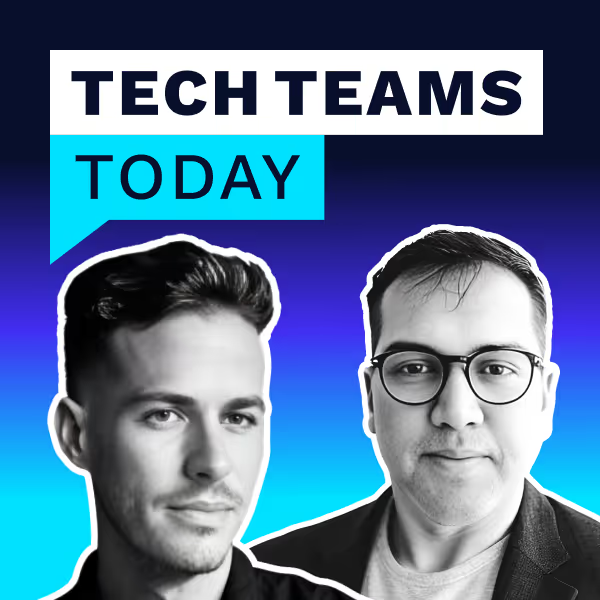A recap of my conversation with Arun Shankar, Director of Engineering at Tubi
Streaming the Super Bowl is no ordinary challenge.
You’re dealing with millions of users, zero margin for error, and one of the biggest tech pressure tests on the planet. In this episode of Tech Teams Today, I sat down with Arun Shankar, Director of Engineering at Tubi, to unpack what it really took to stream the Super Bowl to 15.5 million users—with no crashes, and remarkably low latency.
But this episode wasn’t just about infra. It was about leadership. Team design. Decision-making at scale. And what it means to build resilient, AI-powered engineering orgs in 2025.
Here’s a quick recap of what stood out:
Streaming the Super Bowl wasn’t just about scale. It was about intentional architecture
Before the Super Bowl, Tubi’s OTT apps and backend services were still relying heavily on dynamic servers. Arun and his team knew that wasn’t going to cut it under a Super Bowl-level spike—millions of users hitting the service at once, in a matter of minutes.
So they re-architected. They moved to a multi-CDN, static asset delivery model. They disabled certain features during the game to avoid load spikes. And they had a full rollback and traffic rerouting plan in place for post-game traffic.
It was a high-stakes refactor done under pressure—and it worked.
Key Takeaway: Big moments don’t tolerate weak systems. Build like you expect to be tested.
One config, 30+ platforms. Tubi’s web-based OTT architecture
Most companies wouldn’t dream of launching and maintaining apps on 30+ platforms.
Tubi makes it look routine.
Arun shared how they’ve leaned into a web-first architecture that uses platform-specific build tooling, system APIs, and config flags to power everything from Samsung TVs to gaming consoles—all from a centralized codebase.
Even launching on a new platform can take less than an hour. It’s fast, lean, and deeply efficient and it’s part of what allows Tubi to iterate quickly across so many surfaces.
Key Takeaway: Platform scale doesn’t have to mean platform sprawl if your architecture is smart.
“We’re not hiring coders—we’re hiring product engineers”
This might’ve been my favorite part of the episode.
Arun made it clear that what he looks for in engineers has evolved. It’s no longer just about language proficiency or cranking out clean code. In his words, “LLMs can already do a lot of that better than humans.”
Instead, he looks for engineers who understand the product—people who ask why something needs to be built, not just how. Product intuition, business context, and critical thinking are front and center.
In a world where AI can help fill in syntax and scaffolding, this mindset shift is what separates high-impact engineers from everyone else.
Key Takeaway: In 2025, the best engineers think like PMs and code like architects.
AI tooling is everywhere—but you still need engineering judgment
Tubi is using tools like Cursor for everything from automated test generation to dynamically adapting home screens with config-driven personalization.
But Arun was quick to point out: AI is a tool, not a shortcut.
He’s seen firsthand how engineers can over-rely on LLMs—copy-pasting output without understanding what it’s doing. That might work for a while… until you hit an edge case or production bug you can’t trace.
That’s why he encourages thoughtful use of AI tools: treat them like a junior pair programmer. Helpful, but not responsible for the result.
Key Takeaway: AI can speed you up but only if you stay in the driver’s seat.
Experiments, stability, and avoiding the feature factory
When your app runs across 30+ platforms and 15M+ users, everything becomes an experiment. Arun talked about how even small UI tweaks like tile size or badge placement can make a measurable impact on engagement and conversion.
But they don’t just ship and hope.
The team runs data-informed experiments with clearly defined hypotheses and expected ROI. If something’s not working, they’re not afraid to course correct.
They’ve also put systems in place like internal workshops on data literacy to help engineers make better decisions, not just write better code.
Key Takeaway: High-performing teams build fast—but they build with purpose.
Want more from Arun?
If you haven’t already, check out Arun’s blog post breaking down the Super Bowl infrastructure strategy: 📖 Read the blog
And don’t miss his panel from T3 Live in San Francisco: 🎥 Watch here
Final Thoughts
This episode is one of the best real-world engineering leadership stories I’ve heard in a while. It’s not theory. It’s what happens when a lean team takes on Super Bowl scale and actually delivers.
If you lead a team, ship code at scale, or just want to understand how modern engineering orgs are adapting to AI and velocity—you’ll want to catch this one.
🎧 Watch or listen to the full episode of Tech Teams Today. Available on all major podcast platforms.



.avif)


